In his final public address as the US president on Tuesday, Barack Obama ticked off a number of accomplishments from his eight years in office. Obamacare, the Iran nuclear deal, and the death of Osama Bin Laden were among them. But one unsung aspect of Obama’s legacy is the millions of acres of protected lands he’ll leave behind.
On Dec. 28, Obama designated 1.65 million acres of land—Gold Butte in Nevada and Bears Ears in Utah—as protected national monuments. The additions bring the total number of national monuments established by Obama to 26, more than any president since Theodore Roosevelt signed the Antiquities Act in 1906.
Those 26 monuments amount to 88.3 million acres; Obama has also added 465.2 million acres to existing monuments. In total, he has designated more land, by hundreds of millions of acres, than any other president.
National monuments aren’t always statues or buildings; they can also be vast stretches of canyon, desert, or ocean. This variety is made possible by the Antiquities Act, which gives each president executive authority to protect federal lands from development by designating monuments. The law was a response to widespread theft of historic artifacts, largely in the American southwest.
Since the Antiquities Act was passed, Democratic presidents have established 88 national monuments, comprising about 620 million acres. Republicans have established 66, which cover about 223 million acres. Before Obama, the president with the most acreage of monuments, by far, was George W. Bush:
The vast majority of the acreage designated by Obama and Bush is at sea, including the Pacific Remote Islands Marine National Monument, a large collection of coral reefs, tiny islands, and underwater preserves about 1,000 miles west of Hawaii. Bush originally established the monument in 2009 at 55.6 million acres, then Obama expanded it by 261.3 million acres in 2014. Those kinds of expansions are fairly common, and often transcend party lines.
But while the addition of monuments is generally a non-partisan issue, the executive power that makes them possible can be controversial. When Jimmy Carter designated 15 monuments in Alaska in 1978, for example, many were unhappy to see the federal government take control of public lands. Widespread protests broke out across the state; in Fairbanks, Carter was burned in effigy. An estimated 1,500 protesters began what is now known as the Great Denali Trespass, in which protesters entered the newly protected lands and engaged in activities that were illegal in national monuments, like shooting guns.
One of Obama’s most recent additions is getting pushback as well. State officials in Utah spoke out against the Bears Ears designation, calling it a land grab that takes resources away from citizens. Although a national monument has never been removed by a subsequent president, Utah officials have said they would fight to repeal the monument, and Donald Trump is reportedly “open” to that idea.
